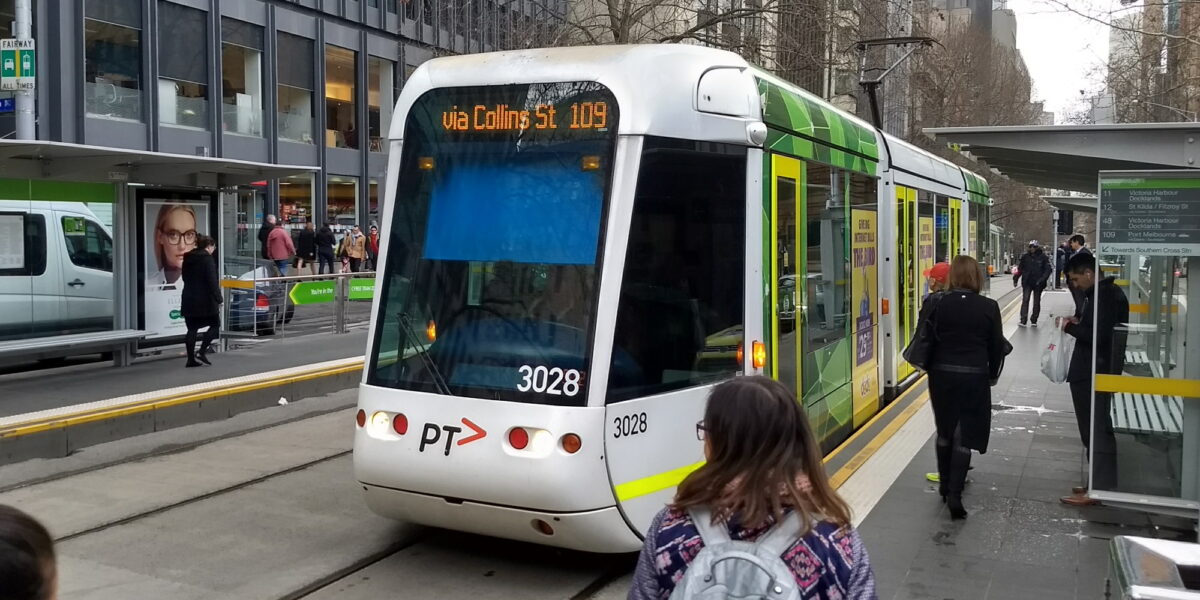Here’s a quick tram video for you. It’s only a couple of minutes long. There’s no sound.
It was recorded last month on a Sunday afternoon on St Kilda Road and Brighton Road.
(There are a few edits – check the dashcam timestamp if you can’t spot the cuts.)
What we’re seeing here is how traffic light priority at intersections can make tram travel time-competitive with driving.
Traffic engineers have provided a brief T light for the tram, before the right turn arrow, at both the Inkerman Street (0:35 seconds into the video) and Carlisle Street intersections (1:05).
Further down the road, trams are excepted from the pedestrian lights near Chapel Street (1:40) – and likewise, pedestrians don’t need to wait for a green man to cross the tracks.
Back at the start of the video, you will also note the departure-side tram stop at Alma Road (0:15) means the tram can leave as soon as possible, but it only helps if the tram has not been delayed at the traffic lights.
The priority provided to trams along here is not even particularly high priority. It barely makes any difference at all to the motorists, but saves the tram enough time to keep moving without too many delays.
On this day, the tram was near empty thanks to COVID-19 travel restrictions, but it could easily have been carrying hundreds of people. Cutting delays to them means more efficient use of the road space.
Cutting delays to trams (and buses) also means better reliability – though it’s important to provide priority not just when the service is late, but to use it to speed up every service.
Fewer delays, and faster journeys means that more trips are more attractive by public transport. Along with better frequency, this helps attract more people out of their cars.
Alas, eventually (after the video ends) the cars caught up to the tram and then overtook it, when we all got to the red light at the Glen Eira Road intersection – with a departure-side stop but no tram priority.
Still, it’s good to see that some intersections give trams a level of priority. These examples show that it’s possible.
More of this around the public transport network would be good, as well as a push on smarter programming that helps trams avoid hitting a red light in the first place – as seen on the Gold Coast Light Rail – would be even better.
- Yes, I was driving my car. Unfortunately the journey wasn’t practical by public transport. And yes the journey was permitted under the CHO’s directions.
- The bus equivalent of these T lights might be a queue jump lane
- Melbourne tram speeds are among the slowest in the world, with up to 17% of the time spent waiting for traffic lights
- In Feb 2019 the State Government announced a trial of traffic light priority on tram route 75

4 replies on “With a little help, trams can be as fast as cars”
While more widespread now, such tram priority lights have been around in Melbourne for a very long time. What is really needed is advance detection, as you mention used by the Gold Coast tram system. I have no memory at all of the tram priority trial written about by Marcus. No doubt I read his post at the time but what happened to the trial?
It would be nice to see more Tram right-of-ways and priority T-lights. For starters here is a lot to learn from Gold Coast and Canberra light rail systems and their effective use of tram priorities.
Informative article.
Your choice of Brighton Road is rather biased since it is full of traffic lights. If you compared tram times for a destination that was serviced by a freeway then the car would have easily won.
I’m all for giving PT priority and making PT the first choice for most trips.
This is great idea, however we could look Clarendon st and Whiteman st when a 96 and 109 tram turn right there is just enough time for one, only both trams and these are on of Melbourne’s busiest routes.